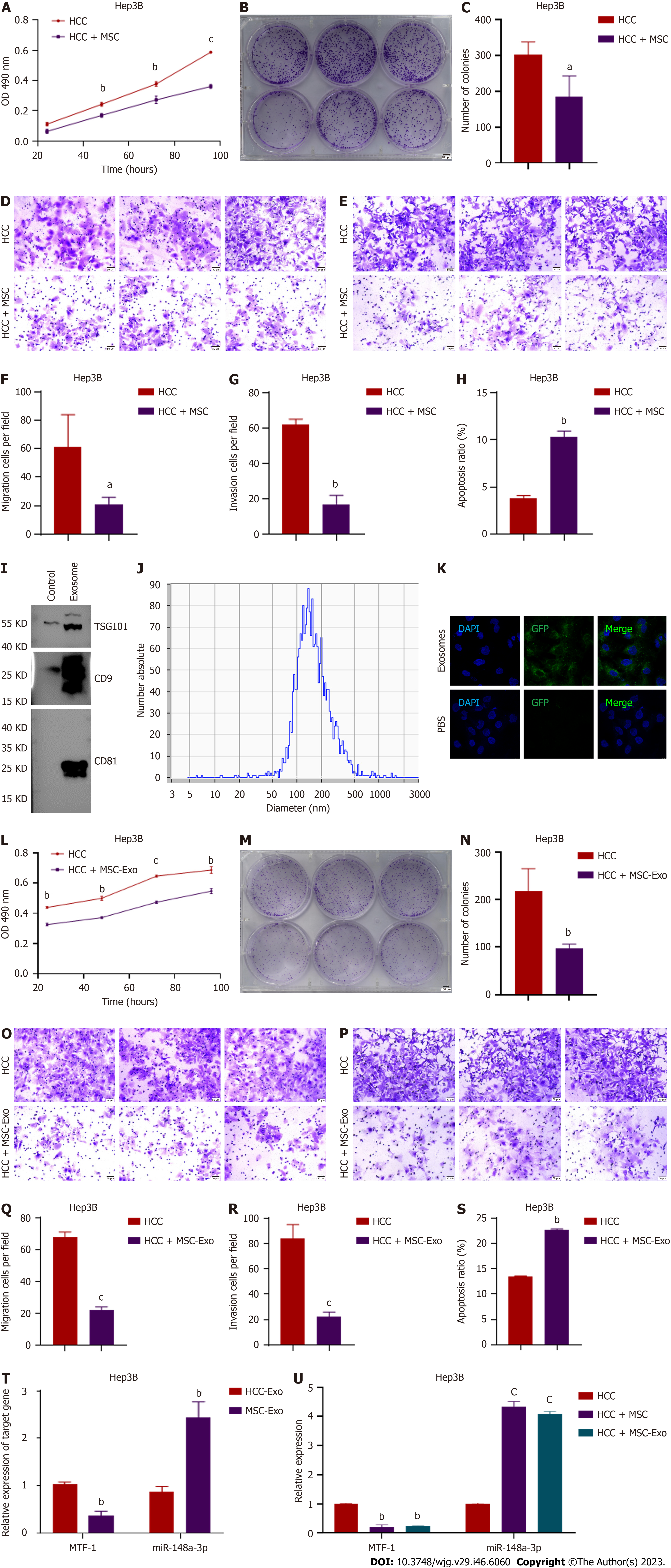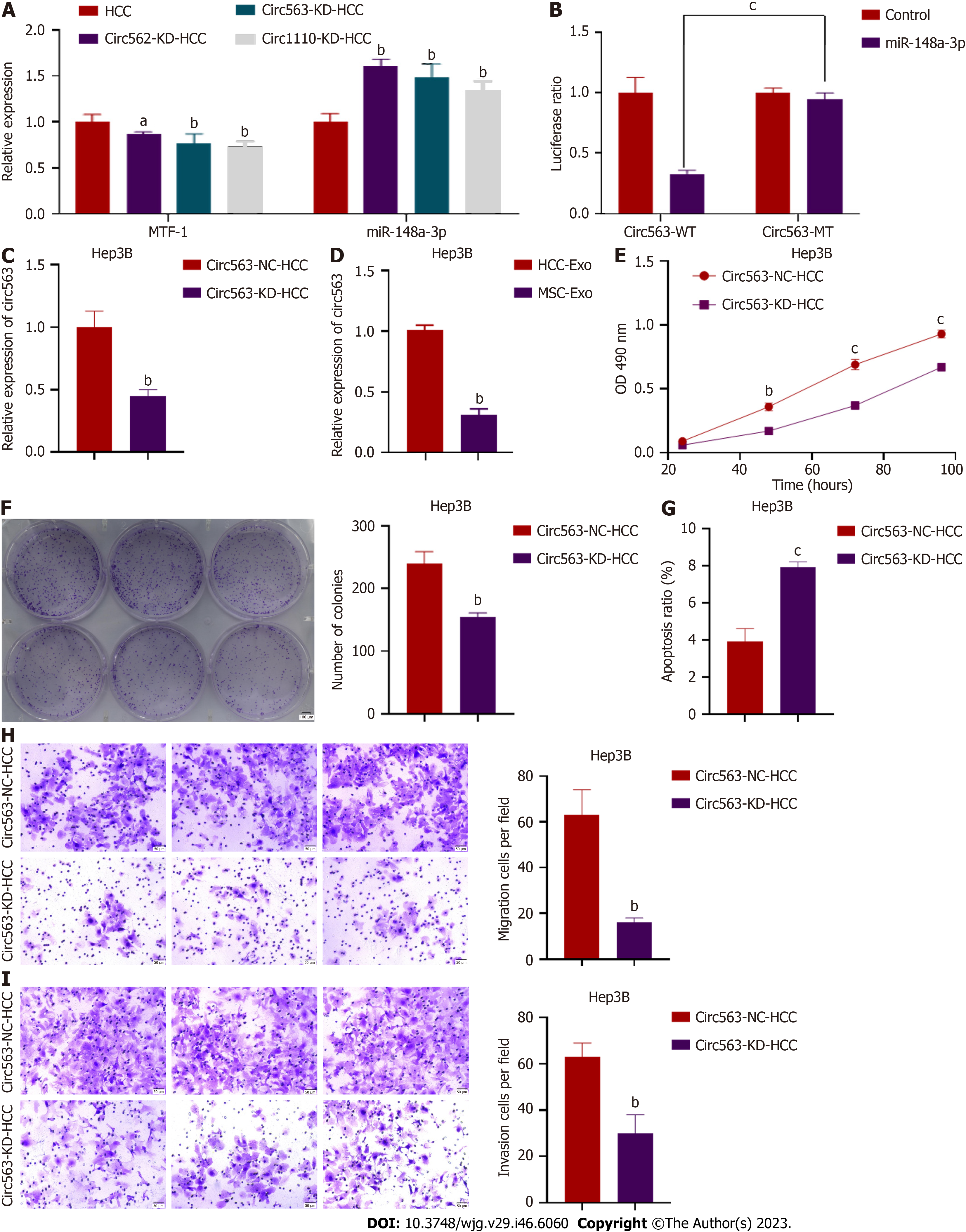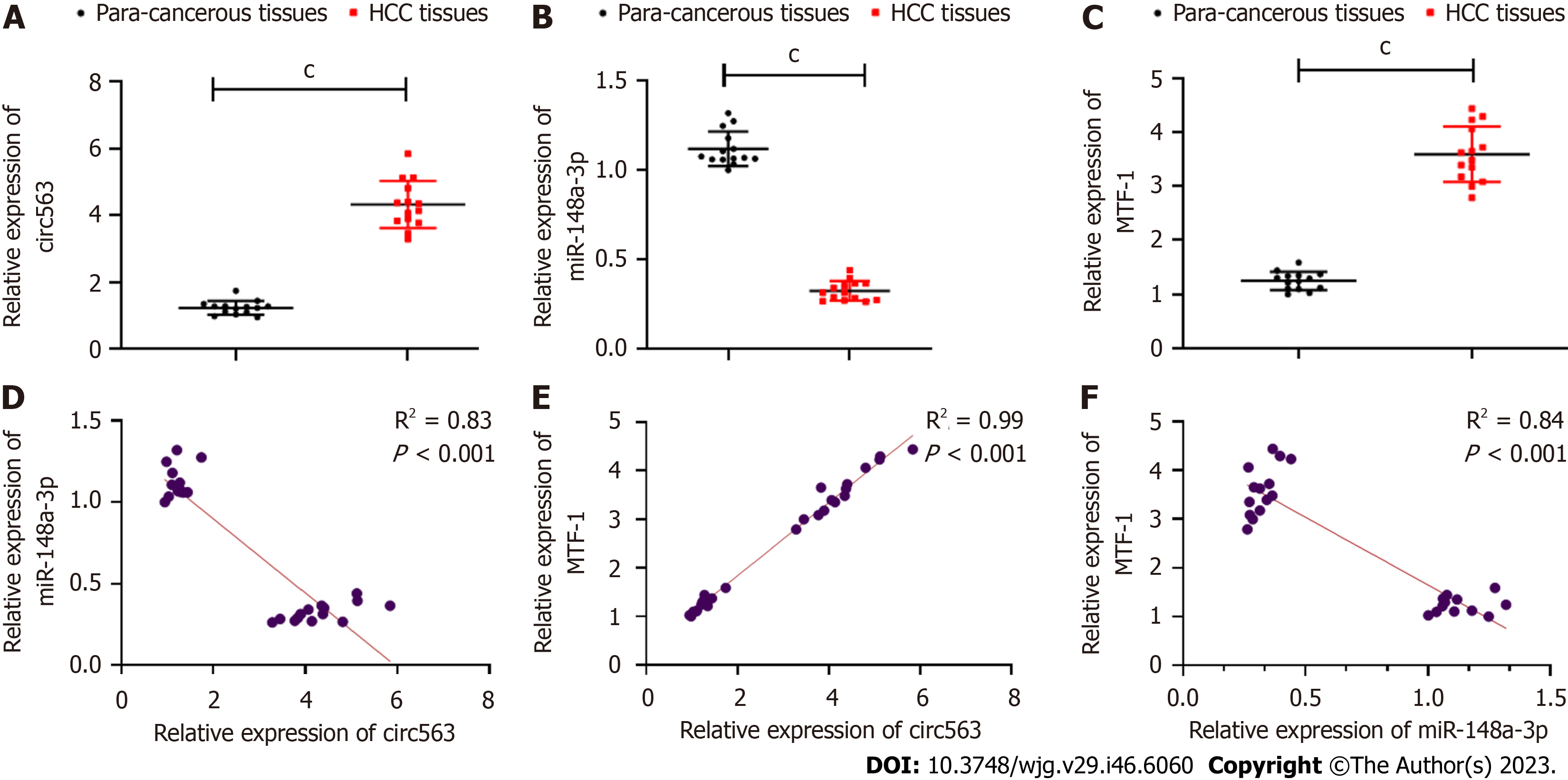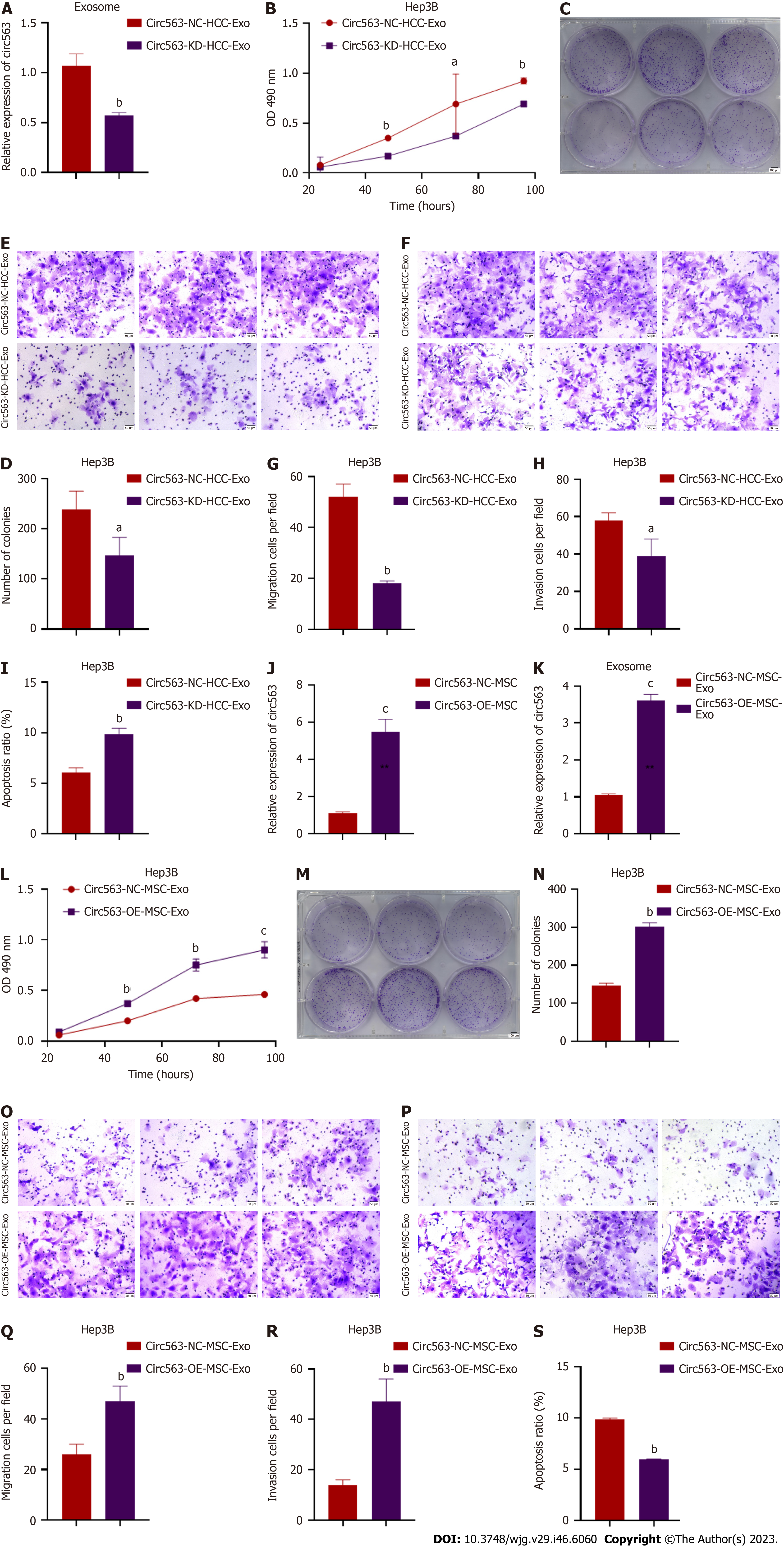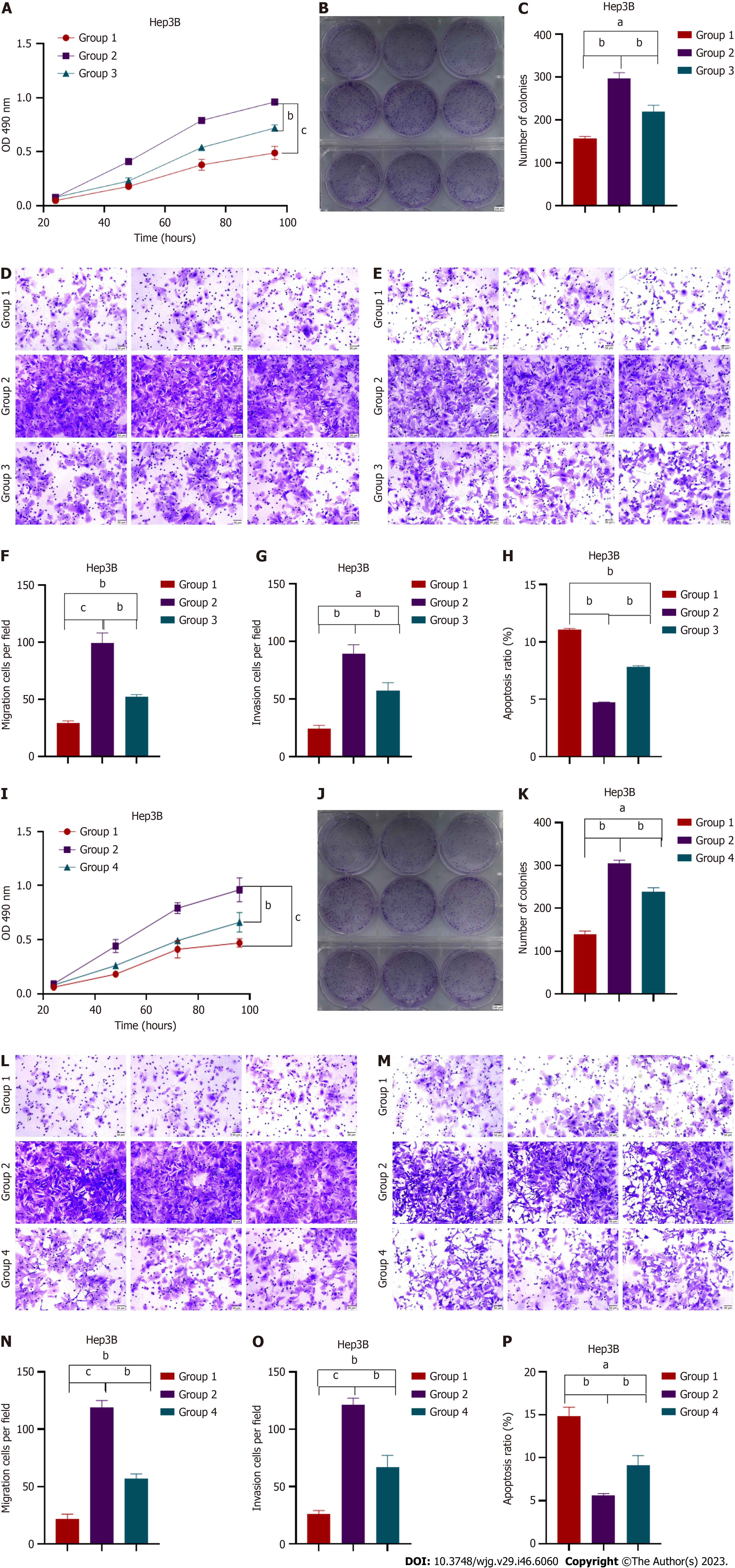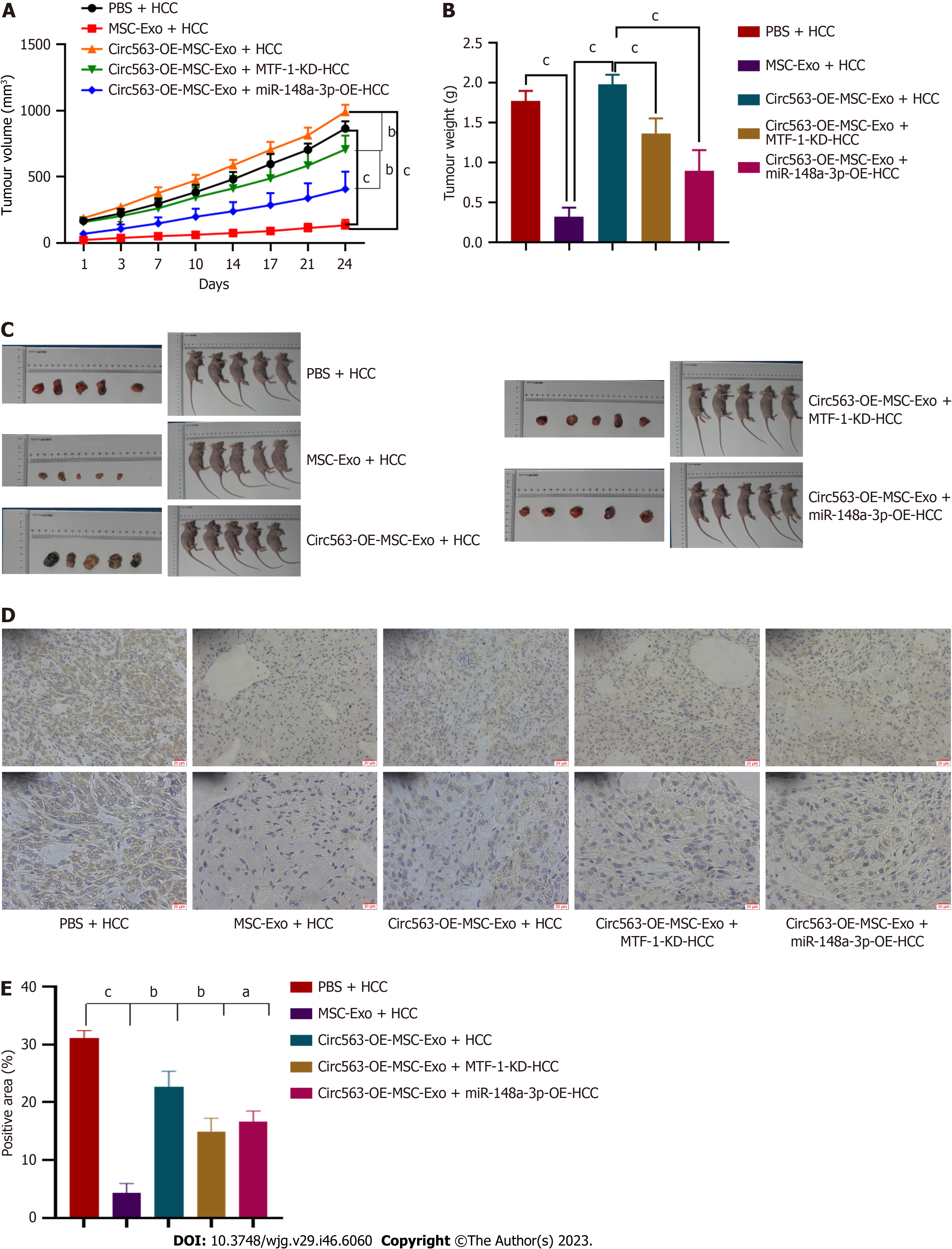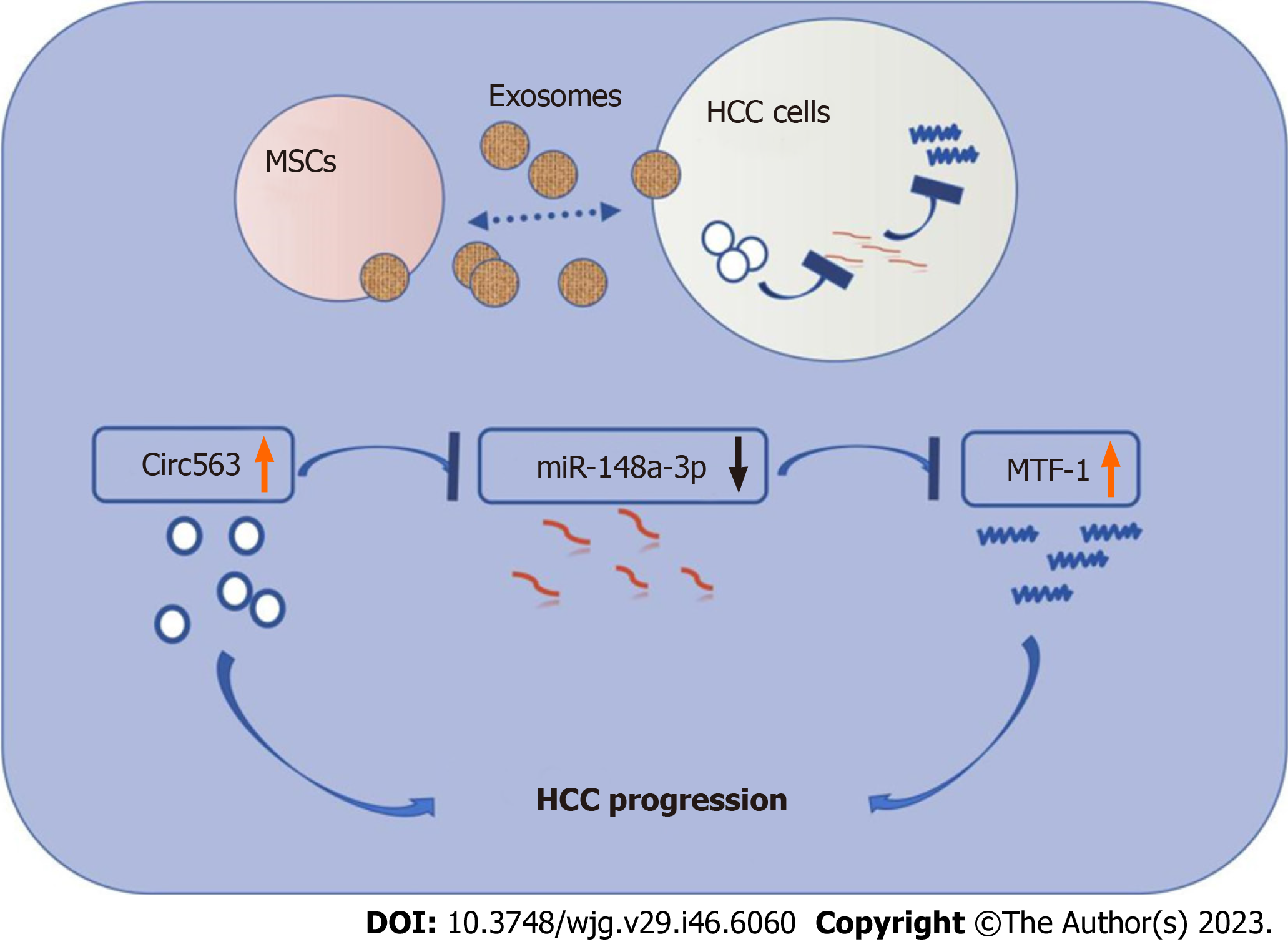Copyright
©The Author(s) 2023.
World J Gastroenterol. Dec 14, 2023; 29(46): 6060-6075
Published online Dec 14, 2023. doi: 10.3748/wjg.v29.i46.6060
Published online Dec 14, 2023. doi: 10.3748/wjg.v29.i46.6060
Figure 1 Effects of mesenchymal stem cells or mesenchymal stem cell-derived exosome co-incubation on Hep3B cells.
A-C: The proliferation of Hep3B cells was measured using 3-(4, 5-dimethylthiazol-2-yl)-2, 5-diphenyltetrazolium bromide and colony formation assays; D-G: Invasion and metastasis were determined using the Transwell assay. Scale bar = 500 μm; H: Cell apoptotic rates were detected after co-incubation using flow cytometry; I: Exosomes were isolated, and specific exosome markers were identified using western blotting; J: The particle size analyzer showed that the average diameter of the vesicles was within the diameter range of exosomes; K: The uptake of labeled exosomes was observed and verified; L-S: Hep3B cell viability and metastasis were both suppressed after exposure to mesenchymal stem cell (MSC)-derived exosomes, and apoptosis was enhanced; T: Comparison of miR-148a-3p and metal-regulatory transcription factor-1 (MTF-1) expression levels in MSC- and hepatocellular carcinoma (HCC)-derived exosomes; U: Assessment of miR-148a-3p and MTF-1 expression by real-time polymerase chain reaction in HCC cells co-cultured with MSC and MSC-derived exosomes. Quantitative data from three independent experiments are shown as the mean ± SD (error bars). aP < 0.05, bP < 0.01, cP < 0.001. HCC: Hepatocellular carcinoma; miRNA: MicroRNA; MSC: Mesenchymal stem cell; MTF-1: Metal-regulatory transcription factor-1; PBS: Phosphate buffered saline.
Figure 2 Identification of hsa_circRNA_0000563.
A: Three circular RNAs (circRNAs) (circ562, circ563, and circ1110) were predicted to most likely bind to miR-148a-3p, and the miR-148a-3p and metal-regulatory transcription factor-1 (MTF-1) levels in hepatocellular carcinoma (HCC) cells transfected with the predicted circRNA were detected by quantitative real-time polymerase chain reaction (RT-PCR); B: A dual-luciferase reporter assay was performed to confirm the direct binding between circ563 and miR-148a-3p based on their complementary sequences; C: The knockdown efficiency was verified by RT-PCR; D: The expression levels of circ563 in exosomes were assessed by RT-PCR; E and F: 3-(4,5-Dimethylthiazol-2-yl)-2,5-diphenyltetrazolium bromide and colony-forming assay results showed that circ563 silencing suppressed cell proliferation and reduced the number of colonies; G: Knockdown of circ563 enhanced Hep3B cell apoptosis as determined by flow cytometry; H and I: Transwell assays revealed that reducing the levels of circ563 impaired the migratory potential and invasiveness of HCC cells. aP < 0.05, bP < 0.01, cP < 0.001. circRNA: Circular RNA; HCC: Hepatocellular carcinoma; Exo: Exosome.
Figure 3 Clinical relevance of circ563 in hepatocellular carcinoma.
To further delineate the role of circ563, hepatocellular carcinoma and paired tumor-adjacent tissues were subjected to real-time polymerase chain reaction. A-C: Enhanced circ563 expression in hepatocellular carcinoma (HCC) tissue was detected compared with that in tumor-adjacent tissues, in line with miR-148a-3p downregulation and metal-regulatory transcription factor-1 (MTF-1) upregulation; D-F: Correlation analyses indicated the relationships between circ563, miR-148a-3p, and MTF-1 expression in HCC. cP < 0.001. circRNA: Circular RNA; HCC: Hepatocellular carcinoma; MTF-1: Metal-regulatory transcription factor-1.
Figure 4 Exosomal circ563 facilitating hepatocellular carcinoma progression.
A: First, a knockdown experiment was conducted in Hep3B cells, and the circ563 levels in Hep3B-derived exosomes were quantified by polymerase chain reaction. Hep3B cell function was assessed after co-treatment with exosomes isolated from the culture medium of circ563-knockdown Hep3B cells; B-D: Downregulation of exosomal circ563 (exo-circ563) reduced Hep3B cell proliferation and the number of colonies formed; E-H: Decreased exo-circ563 levels suppressed the migratory activity and invasiveness of the Hep3B cells; I: The downregulation of exo-circ563 was correlated with apoptosis induction; J: The efficiency of circ563 overexpression in the mesenchymal stem cells (MSCs) was determined by quantitative real-time polymerase chain reaction; K: The upregulation of circ563 in MSC-derived exosomes was confirmed; L-R: The hepatocellular carcinoma (HCC) cell proliferation, metastasis, and apoptosis rates were assessed following exosome treatment. Exo-circ563 significantly induced HCC cell proliferation, migration, and invasion; S: Flow cytometry analysis showed that the percentage of apoptotic cells was significantly decreased. aP < 0.05, bP < 0.01, cP < 0.001. exo-circ563: Exosomal circ563; HCC: Hepatocellular carcinoma; MSC: Mesenchymal stem cell; Exo: Exosome.
Figure 5 Oncogenic effect of exosomal circ563 prevented by either miR-148a-3p upregulation or metal-regulatory transcription factor-1 knockdown.
A-P: Exosomal circ563 promoted Hep3B cell proliferation and invasion, which were reversed by miR-148a-3p overexpression or metal-regulatory transcription factor-1 depletion. Group 1: Co-culturing Hep3B cells with mesenchymal stem cell (MSC)-derived exosomes; Group 2: Co-culturing Hep3B cells with exosomes derived from circ563-overexpressing MSCs; Group 3: Co-culturing Hep3B cells after miR-148a-3p upregulation with exosomes derived from circ563-overexpressing MSCs; and Group 4: Co-culturing Hep3B cells after metal-regulatory transcription factor-1 knockdown with exosomes derived from circ563-overexpressing MSCs. aP < 0.05, bP < 0.01, cP < 0.001.
Figure 6 Circ563 promoting hepatocellular carcinoma tumor growth in vivo.
Mouse xenografts were generated to verify the role of circ563 in vivo. Hepatocellular carcinoma cells stably transfected with miR-148a-3p overexpression, metal-regulatory transcription factor-1 knockdown, or control vectors were implanted into the subcutaneous tumors of mice. The xenografts were treated with exosomes after four weeks. A-C: Accelerated growth of circ563-overexpressing Hep3B-derived xenografts is shown with increased tumor volume and weight compared with the control group. Both miR-148a-3p overexpression and metal-regulatory transcription factor-1 (MTF-1) depletion partially reversed the increase in tumor volume and weight; D and E: MTF-1 staining reveals a similar trend with cell growth. aP < 0.05, bP < 0.01, cP < 0.001. exo-circ563: Exosomal circ563; HCC: Hepatocellular carcinoma; MSC: Mesenchymal stem cell; Exo: Exosome; MTF-1: Metal-regulatory transcription factor-1.
Figure 7 The schematic model of circ 563/miR-148a-3p/metal-regulatory transcription factor-1 in hepatocellular carcinoma.
MTF-1: Metal-regulatory transcription factor-1; HCC: Hepatocellular carcinoma; MSCs: Mesenchymal stem cells.
- Citation: Lyu ZZ, Li M, Yang MY, Han MH, Yang Z. Exosome-mediated transfer of circRNA563 promoting hepatocellular carcinoma by targeting the microRNA148a-3p/metal-regulatory transcription factor-1 pathway. World J Gastroenterol 2023; 29(46): 6060-6075
- URL: https://www.wjgnet.com/1007-9327/full/v29/i46/6060.htm
- DOI: https://dx.doi.org/10.3748/wjg.v29.i46.6060













